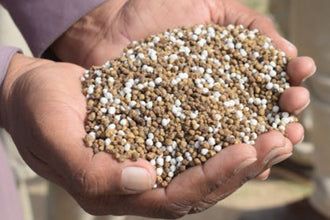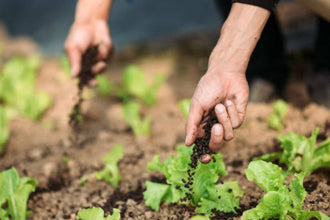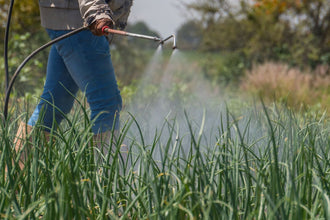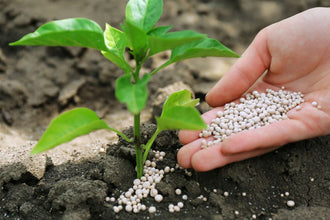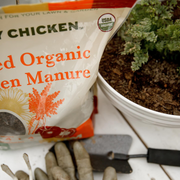
Understanding fertilizer types can make or break your gardening game. You've probably stood in the garden center staring at dozens of bags and bottles, wondering which one will actually help your plants grow better. The truth is, every plant needs different things, and picking the right fertilizer can turn your struggling garden into something you're proud to show off.
Most gardeners get overwhelmed by all the choices out there. You've got organic options, synthetic blends, slow-release granules, and liquid concentrates. Some promise quick results while others work for months. The secret is matching what your plants actually need with the right type of fertilizer.
Basic Fertilizer Categories You Should Know
Before you start shopping for fertilizer types, you need to understand how they're made and how they work. This stuff matters because it affects everything from how fast you'll see results to how often you need to reapply.
Organic vs Synthetic Fertilizers
Organic fertilizers come from stuff that was once alive. We're talking composted leaves, animal manure, fish emulsion, and ground-up bones. These fertilizer types work by feeding the tiny creatures living in your soil. Those microbes break down the organic matter and turn it into food your plants can actually use.
Synthetic fertilizers get made in factories using chemicals. They skip the whole soil microbe process and deliver nutrients straight to your plant roots. Your plants can use these nutrients right away, which is why you see results so fast.
Here's the thing about choosing between these fertilizer types. Organic options take longer to work, but they make your soil healthier over time. Synthetic fertilizers give you quick results but don't do much for your soil's long-term health.
Fast-Acting vs Slow-Release Options
Fast-acting fertilizer types dissolve in water and get to work within days. Your plants perk up quickly, leaves get greener, and growth speeds up. The downside is you need to apply these more often because rain and watering wash the nutrients away.
Slow-release fertilizers break down gradually over several months. You apply them once and they keep feeding your plants for a long time. Many of these fertilizer types use special coatings on the granules that control how fast nutrients get released.
Some companies make controlled-release fertilizers that are even more precise. These fertilizer types use fancy polymer coatings that release nutrients at specific rates no matter what the weather does. They cost more upfront but save you time and work better than regular slow-release options.
Different Forms of Fertilizer Types
The way fertilizer types are packaged affects how you use them and how quickly they work. Each form has its own advantages depending on what you're trying to grow and how you like to garden.

Granular Fertilizers
Granular fertilizer types look like tiny pellets that you sprinkle on top of your soil. Most of these are slow-release formulas that break down over weeks or months. They work great for big areas like lawns or when you want to feed established plants without rushing around every week.
These fertilizer types don't wash away as easily when it rains hard. You can use a spreader to get even coverage across large spaces, which saves time and prevents over-fertilizing in spots. Lots of organic fertilizer types come in granular form because they naturally release nutrients slowly anyway.
Liquid Fertilizers
Liquid fertilizer types get nutrients to your plants fast. You can buy concentrated liquids that you mix with water, or ready-to-use bottles that don't need mixing. Plants can absorb liquid nutrients through their roots or even through their leaves.
The leaf-feeding trick works especially well for fixing nutrient problems quickly. But liquid fertilizer types wash away easily, so you'll need to reapply them more often than granular versions. They're perfect when you need fast results or want to give your plants a quick boost.
Water-Soluble Powders
Water-soluble fertilizer types come as crystals or powders that completely dissolve in water. They work similar to liquid fertilizers but usually cost less and take up less storage space. Many flower fertilizers come this way because you can mix different strengths for different times of the year.
These fertilizer types work well for potted plants and greenhouse growing where you control the watering. You can run them through drip irrigation systems or just mix them in your watering can.
Specialized Fertilizer Types for Specific Jobs
Different plants and situations need different fertilizer types designed for specific purposes. Knowing about these specialty options helps you pick exactly what your garden needs instead of guessing with general-purpose products.
Starter Fertilizers
Starter fertilizer types pack extra phosphorus to help new plants develop strong roots. Use these when you're planting seeds, moving transplants, or putting in new trees and shrubs. The phosphorus helps plants focus on building good root systems before they put energy into growing leaves and stems.
Most starter fertilizers mix fast-acting nutrients with slow-release ones. The fast stuff feeds plants right away while they're getting established, and the slow-release part keeps working as the roots spread out.
Lawn Fertilizers
Lawn fertilizer types get specially mixed for grass nutrition. They usually have lots of nitrogen to make your grass thick and green. Many lawn fertilizers also include weed preventer to stop new weeds from sprouting.
Different seasons call for different lawn fertilizer types:
-
Spring formulas focus on nitrogen for quick green-up after winter
-
Summer blends provide steady nutrition without promoting too much growth during hot weather
-
Fall fertilizers emphasize phosphorus and potassium to strengthen roots before winter
Specialty Plant Fertilizers
Some plants have picky eating habits. Acid-loving plants like blueberries and azaleas need fertilizer types that keep soil pH low. These products contain sulfur or other ingredients that make soil more acidic while providing nutrients.
Vegetable fertilizer types often include extra calcium to prevent problems like blossom end rot in tomatoes and peppers. Flowering plant fertilizers usually have more phosphorus to encourage blooms instead of just leafy growth.
Understanding Nutrient Content in Fertilizer Types
Every fertilizer bag shows three numbers that tell you what's inside. These NPK numbers represent the percentages of nitrogen, phosphorus, and potassium. Understanding these numbers helps you pick fertilizer types that match what your plants actually need.
Complete vs Incomplete Fertilizers
Complete fertilizer types contain all three main nutrients your plants need. The numbers might look like 10-10-10 for balanced nutrition or 20-5-10 when you need more nitrogen. These work well for general gardening when you want to cover all the bases.
Incomplete fertilizer types focus on one or two nutrients. Pure nitrogen fertilizers like urea show up as 46-0-0 on the label. Bone meal gives you phosphorus at 3-15-0. Use these when soil tests show you're missing specific nutrients.
Balanced vs Targeted Ratios
Balanced fertilizer types have similar NPK numbers like 10-10-10 or 15-15-15. They work fine for general use when you don't know exactly what your soil needs or what your plants want.
Targeted fertilizer types have uneven ratios designed for specific purposes:
-
High nitrogen (like 30-10-10) makes leaves green and promotes fast growth
-
High phosphorus (like 10-30-10) encourages flowers and strong roots
-
High potassium (like 10-10-30) helps plants handle stress and disease
How to Apply Different Fertilizer Types
Getting fertilizer types applied correctly makes the difference between healthy plants and wasted money. Different products need different application methods, and timing matters just as much as technique.
Broadcasting vs Targeted Applications
Broadcasting means spreading fertilizer types evenly over large areas. This works great for lawns and established garden beds where you want to feed everything uniformly. Granular fertilizer types are easiest to broadcast using wheeled spreaders.
Targeted application puts fertilizer types right where plants can use them best. Side-dressing vegetable rows with granular fertilizer or applying liquid fertilizer types around root zones saves product and works more effectively.
Timing Your Applications
Pre-plant fertilizer types get worked into soil before you put plants in the ground. These usually contain slow-release formulations that feed plants all season long. Working organic fertilizer types into planting beds improves soil structure while providing nutrition.
Maintenance feeding uses fertilizer types during the growing season to keep plants healthy and productive. Fast-acting liquid fertilizer types work well for this because you can adjust timing and amounts based on how your plants look and grow.
Choosing the Right Fertilizer Types for Your Garden
Picking the best fertilizer types depends on what you're growing, your soil conditions, and what you want to accomplish. Think about these factors when you're shopping for garden products.
Your soil type changes how different fertilizer types perform. Sandy soils drain fast and might need more frequent applications of quick-acting fertilizer types. Clay soils hold nutrients longer but often benefit from organic fertilizer types that improve soil structure over time.
Plant growth stages also influence which fertilizer types work best. Young plants often need starter fertilizers with extra phosphorus, while mature plants might need maintenance fertilizers with balanced nutrition or special ratios for specific goals like more flowers.
Fancy Chicken Organic Pelletized Chicken Manure: Premium Soil Building
Among organic fertilizer types, Fancy Chicken stands out as a premium choice that transforms your soil into a thriving ecosystem. This pelletized chicken manure delivers a balanced 4-2.5-2 NPK ratio while building long-term soil health that chemical alternatives simply can't match.
Why Fancy Chicken Works Better Than Other Organic Options
Fancy Chicken's pelletized format makes it easier to handle and apply than raw manure or compost. The pellets break down gradually, feeding beneficial soil microbes that create a healthy growing environment. Unlike synthetic fertilizer types that only feed plants, Fancy Chicken actually improves your soil structure season after season.
The 4-2.5-2 nutrient profile provides exactly what most gardens need:
-
Moderate nitrogen for steady, healthy growth without burning plants
-
Balanced phosphorus to strengthen root systems and improve flowering
-
Adequate potassium for disease resistance and overall plant health
-
Slow-release nutrition that feeds plants for 4-6 weeks per application
What Makes Fancy Chicken Different From Regular Chicken Manure
Raw chicken manure can burn plants and smells terrible. Fancy Chicken's pelletized chicken manure gets processed to eliminate these problems while concentrating the nutrients. The pellets won't attract flies or create odor issues in your garden.
This processing also makes the nutrients more available to plants while maintaining the organic benefits. You get consistent results without the guesswork that comes with fresh manure or home-composted materials.
Perfect Plants for Fancy Chicken Fertilizer
Fancy Chicken works as an all-purpose organic fertilizer for virtually any garden situation:
Vegetables and Herbs
-
Tomatoes, peppers, and leafy greens thrive with the balanced nutrition
-
Root vegetables develop better flavor and storage quality
-
Herbs become more aromatic and productive
Flowers and Ornamentals
-
Perennial flowers show stronger blooms and extended flowering periods
-
Annual bedding plants maintain color and growth all season
-
Roses and other flowering shrubs develop better disease resistance
Lawn and Turf Areas
-
Grass develops deeper roots and better drought tolerance
-
Reduces need for frequent watering and chemical treatments
-
Creates thicker, healthier turf that crowds out weeds naturally
Application Tips for Best Results
Apply Fancy Chicken every 4-6 weeks during the growing season for sustained nutrition. Work the pellets into the top few inches of soil around established plants, or mix into planting beds before setting out new plants.
For containers and raised beds, use about 1-2 tablespoons per square foot. Larger garden areas need roughly 2-3 pounds per 100 square feet. Water thoroughly after application to start the slow-release process.
The pelletized format means you can apply Fancy Chicken any time without worrying about burning plant roots. This makes it safer and more convenient than many other organic fertilizer types that require careful timing and application methods.
Start Growing Better Plants Today
Now you know enough about fertilizer types to make smart choices for your garden. Whether you go with organic options that build soil health or synthetic versions for quick results, matching fertilizer types to your specific situation creates healthier plants and better harvests.
Begin by figuring out what your plants actually need and what kind of soil you're working with. Pick fertilizer types that match your gardening goals, whether that's fast results, long-term soil improvement, or specialized nutrition for particular plants. Your garden will reward you with stronger growth and better yields when you feed it right.




